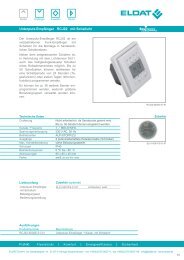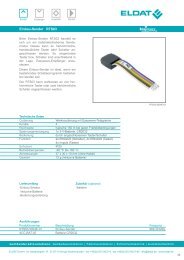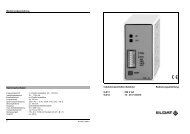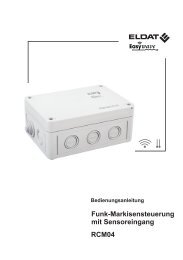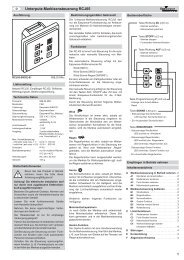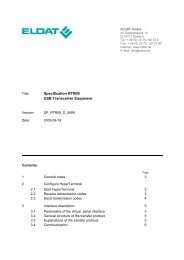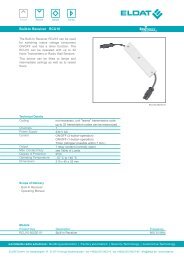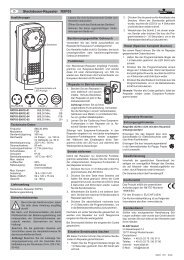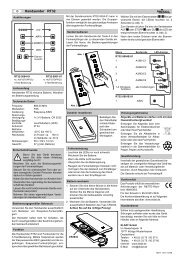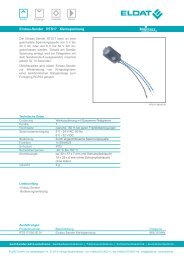Specification of RTRM08 Transceiver Module Easywave I2C - ELDAT
Specification of RTRM08 Transceiver Module Easywave I2C - ELDAT
Specification of RTRM08 Transceiver Module Easywave I2C - ELDAT
Create successful ePaper yourself
Turn your PDF publications into a flip-book with our unique Google optimized e-Paper software.
<strong>Specification</strong><br />
Index 1.01<br />
Project No.<br />
RF-Products, Controller <strong>RTRM08</strong> <strong>Transceiver</strong> <strong>Module</strong> Easw I 2 C Page 18<br />
Development<br />
Production S. Schreiber 2007-08-24<br />
Register<br />
Address<br />
Register Name Description <strong>of</strong> Register<br />
0x20 RX_LN_CH0_7 A bit mask that indicates whether a channel has learned an <strong>Easywave</strong><br />
telegram (receive).<br />
7007<br />
A bit for the specific channel is set to 1 upon learning an <strong>Easywave</strong><br />
telegram (LN_RQ and LN_PL value <strong>of</strong> the RX_MODE register, please refer<br />
to “Learning <strong>of</strong> <strong>Easywave</strong> Telegrams“ on page 21.)<br />
A specific bit is cleared upon deletion <strong>of</strong> a learned <strong>Easywave</strong> telegram<br />
(DELLN value <strong>of</strong> the RX_MODE register, please refer to “Delete Learned<br />
<strong>Easywave</strong> Telegrams“ on page 22.)<br />
Any bit is cleared when <strong>ELDAT</strong> ships the transceiver module <strong>RTRM08</strong>.<br />
• Bit 0: Channel 0 (channel number <strong>of</strong> the RX_CHANNEL register);<br />
• Bit 1: Channel 1 (channel number <strong>of</strong> the RX_CHANNEL register);<br />
• Bit 2: Channel 2 (channel number <strong>of</strong> the RX_CHANNEL register);<br />
• Bit 3: Channel 3 (channel number <strong>of</strong> the RX_CHANNEL register);<br />
• Bit 4: Channel 4 (channel number <strong>of</strong> the RX_CHANNEL register);<br />
• Bit 5: Channel 5 (channel number <strong>of</strong> the RX_CHANNEL register);<br />
• Bit 6: Channel 6 (channel number <strong>of</strong> the RX_CHANNEL register);<br />
• Bit 7: Channel 7 (channel number <strong>of</strong> the RX_CHANNEL register)<br />
0x21 RX_LN_CH8_15 Just as the RX_LN_CH0_7 register, but for channels 8 to 15.<br />
• Bit 0: Channel 8 (channel number <strong>of</strong> the RX_CHANNEL register);<br />
• Bit 1: Channel 9 (channel number <strong>of</strong> the RX_CHANNEL register);<br />
• Bit 2: Channel 10 (channel number <strong>of</strong> the RX_CHANNEL register);<br />
• Bit 3: Channel 11 (channel number <strong>of</strong> the RX_CHANNEL register);<br />
• Bit 4: Channel 12 (channel number <strong>of</strong> the RX_CHANNEL register);<br />
• Bit 5: Channel 13 (channel number <strong>of</strong> the RX_CHANNEL register);<br />
• Bit 6: Channel 14 (channel number <strong>of</strong> the RX_CHANNEL register);<br />
• Bit 7: Channel 15 (channel number <strong>of</strong> the RX_CHANNEL register)<br />
0x22 RX_LN_CH16_23 Just as the RX_LN_CH0_7 register, but for channels 16 to 23.<br />
• Bit 0: Channel 16 (channel number <strong>of</strong> the RX_CHANNEL register);<br />
• Bit 1: Channel 17 (channel number <strong>of</strong> the RX_CHANNEL register);<br />
• Bit 2: Channel 18 (channel number <strong>of</strong> the RX_CHANNEL register);<br />
• Bit 3: Channel 19 (channel number <strong>of</strong> the RX_CHANNEL register);<br />
• Bit 4: Channel 20 (channel number <strong>of</strong> the RX_CHANNEL register);<br />
• Bit 5: Channel 21 (channel number <strong>of</strong> the RX_CHANNEL register);<br />
• Bit 6: Channel 22 (channel number <strong>of</strong> the RX_CHANNEL register);<br />
• Bit 7: Channel 23 (channel number <strong>of</strong> the RX_CHANNEL register)



